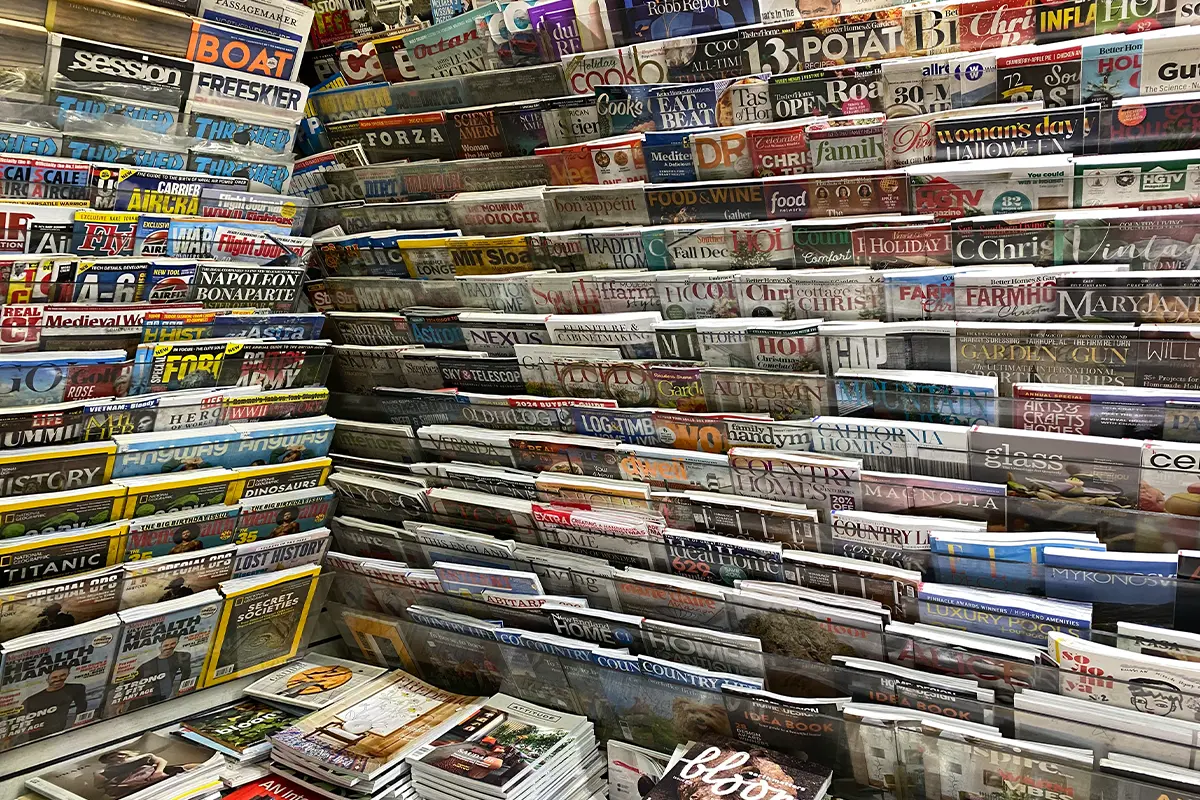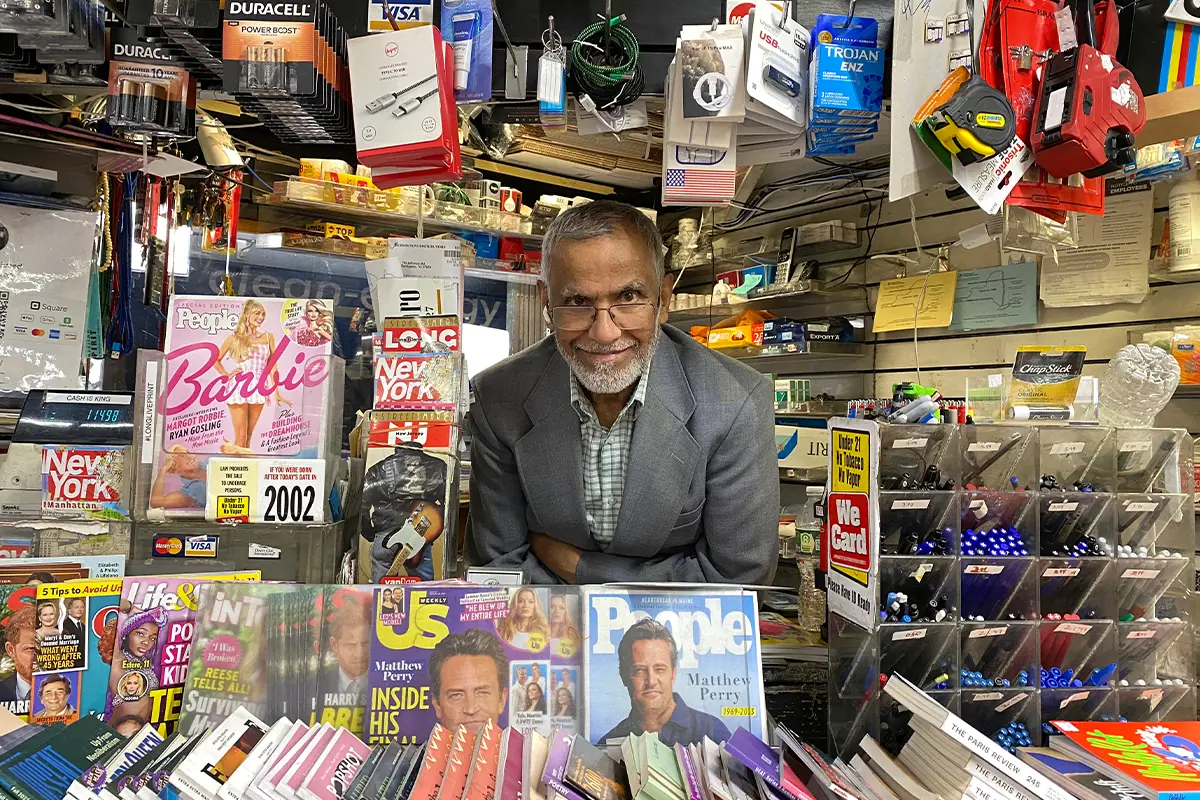At Casa Magazines, «inclusivity extends to independent creators – to those who walk in with their merch saying, ‘I want to sell my magazine here’, Casa responds with ‘How many copies do you want to leave?»
Casa Magazines: niche publications stacked along walls at 8th Avenue and 12th Street, West Village, New York City
With a history spanning centuries, the West Village was originally settled by the Dutch in the 17th century, evolving from farmland and tobacco fields to a burgeoning residential district in the late 18th century. Throughout the 19th century, the neighborhood drew in a mix of immigrants, artists, and writers, shaping its character with the construction of row houses and brownstones.
In the 1940s and 1950s, the streets of the West Village became a gathering place for literaries like Jack Kerouac, Allen Ginsberg, and William S. Burroughs. The Beat poets and writers played a role in establishing the neighborhood’s reputation as a hub of literary and cultural innovation. The 1960s witnessed the emergence of the folk music revival, with venues like The Gaslight Cafe and musicians like Bob Dylan becoming synonymous with the neighborhood’s music scene. Throughout its history, this area has maintained its status as a nexus for artistic expression, social activism, and cultural innovation.
«Today the Village is mostly populated by professionals: including photographers, fashion stylists, and the creative community, who appreciate it more. Celebrities like Julian Moore and Philip Seymour Hoffman live their lives here». Established in the 1970s and located at 8th Avenue and 12th Street, in the heart of the Village, Casa Magazines saw a transition in 1994 when Mohammed Ahmed assumed control. Despite the abundance of publications filling every corner of Casa, one of the last-standing magazine shops in New York City, Mohammed and Ali Wasim possess a familiarity with the precise location of each title.
How Casa Magazines nyc faces the challenges of physical communication today in an era of digital subscriptions
Reflecting on the shop’s early days, Mohammed shares that «when we started, we didn’t have so many magazines. Then we rebuilt the magazine selection based on customer demand: whatever the customer asked for, we made sure to provide». Born shortly after Hyderabad’s forcible absorption into India in 1948, Mohammed brings his perspective to Casa Magazines. Syed Khalid Wasim, known as Ali, was born in Karachi, Pakistan, and always wanted to be a photographer.
«Newsstands were much more frequented back then because all the news came through them. Mohammed used to tell me about how many New York Times newspapers would sell in one day – four thousand copies for the entire week. This was because official news had to come from news outlets. Especially during events like 9/11, when things were uncertain, people would line up for the latest news. They wanted to be the first to get fresh news off the press, whether it was about 9/11, Princess Diana, or Obama’s victory. In those days, there was a push for retailers, but now the emphasis is on home delivery and digital subscriptions».
The role of community-building in information consumption at Casa Magazines
Lately, Mohammed and Ali started working with Happy and Tammy David: Happy is the partnership marketing and creative strategy expert at Casa Magazines and a longstanding friend of Mohammed, Ali, and Imran, a former sales associate at Casa. She initiated the Casa Magazines Instagram account in 2017. Tammy, a photographer and content strategist based in Manila, Philippines, has also joined the collaboration.
«There’s a difference in how people prefer to consume information now compared to the past, in terms of timing. People are coming back, though, because of platforms like Instagram and digital media, especially since there are fewer stores of this kind in Manhattan. That’s why people are looking for places to go, such as McNally Jackson and Iconic Magazines», Happy explains.
«Creating a community is perhaps difficult in a big city like New York – it’s not common to have a friend who watches out for kids, cares for the elderly, knows everyone, and treats everyone equally».
«What’s also particular about Casa is its location: aside from the small businesses, it’s not too far from the Whitney Museum and other small neighborhoods. The West Villagers themselves are passionate about their neighborhood. Many of them have gatherings, plan fundraisers, and take care of the parks. They will revolt, I think, despite the influx of tourists and the Sex and the City onslaught that brought big fashion houses to Bleecker Street», she adds.
Strategizing survival amidst the fast-paced information culture of NYC: Casa Magazines offers a selection of rare titles and niche publications to its customers
«We are in Midtown Manhattan – people in New York don’t want to waste their time. If they’re near and an issue comes out, and they call Casa, and we don’t have it yet, why would they keep coming back? Also, if every distributor has the same selection and everybody can access the same magazines, what’s going to be different? The real secret to Casa is Mohammed and Ali’s presence».
The ace of Casa Magazines is that it allows you to bump into a mini version of New York: because Mohammed sells everything, Casa attracts all kinds of people and all kinds of materials. The second community that he contributes to and is proud to be a part of, aside from that of the Villagers, is the publishing one. «What sets Casa apart for magazine enthusiasts like myself is the availability of rare titles that are hard to find elsewhere. From basketball magazines to zines and specialty publications, Casa strives to offer a platform for smaller, often overlooked titles».
Casa Magazines –An inclusive community centered around independent publishing
Happy and Tammy explain that «the inclusivity extends to independent creators – those who walk in with their merchandise find a welcoming space. ‘I want to sell my magazine here’, they say, and Casa responds with, ‘How much? How many copies do you want to leave? How many do you want to sell?’ The patrons of Casa are not just customers; they are the creative minds behind the magazines – photographers, writers, and artists. This creates a global community centered around newsstands and independent publishing».
«Growing up, I used to see these names in magazines, and now I see them following my sister on Instagram – Penny Jane Martin from Gentlewoman, Matt Willey, who used to be with Port Magazine and is now with Pentagram and designed a t-shirt to help support Casa Magazines. They all come together because they know that Casa Magazines is very active in promoting all of these magazines and titles. It’s like if you’re in media, you stop by here, and you know this is like your Clubhouse».
Respecting creators at Casa Magazines. The value of print work
When you enter Casa Magazines, one thing you notice while navigating between magazines and publications is a small sign that reads ‘no photos’. Happy explains that one of the pain points Mohammed told her in the beginning was that people would come in and snap a picture: «We needed to have signage to remind people that you think it’s harmless to just take a photo. But It’s not». She explains that «the signage is over there, but it’s not just about that. It’s about people’s jobs, about the fact that people create these magazines, titles, illustrations, and graphics. And when we take a picture, it’s not like stealing something, but it does not support the people who come together to create this. To respect their work, we ask to limit your browsing».
«People realized that you can find everything on the internet, but in newspapers and magazines, you can find something more specific. More exclusive. With the paper, you’re being forced to focus, not looking at your phone, appreciating the layout, the way you can’t just scroll through».
Casa Magazines, Manhattan – New York City
Casa Magazines, New York is a magazine lovers mecca offering over 2,500 titles from fashion glossies to niche interest plus daily papers. Acquired by Mohammed Ahmed in 1994, he earned the moniker ‘the last king of print’.




















